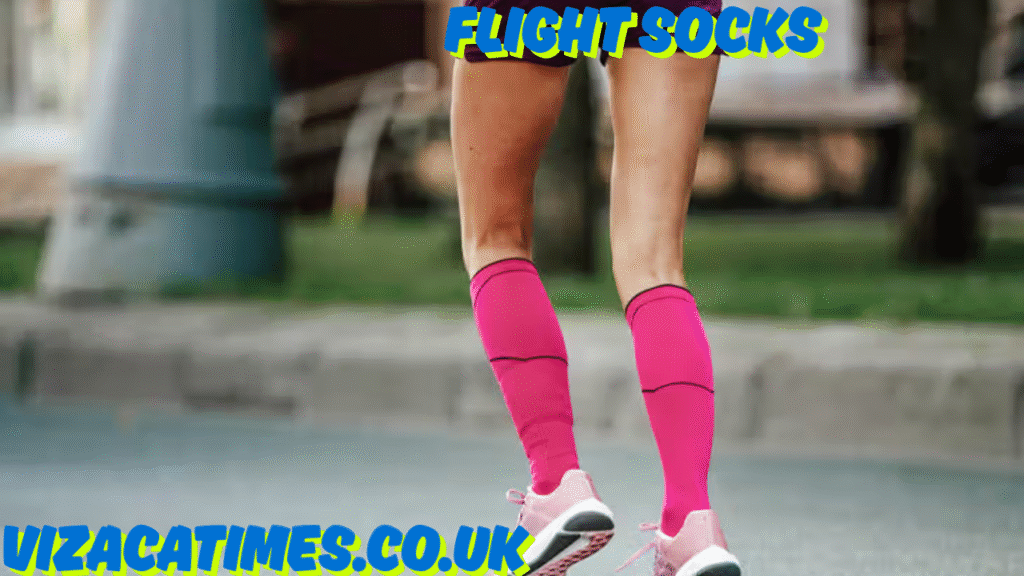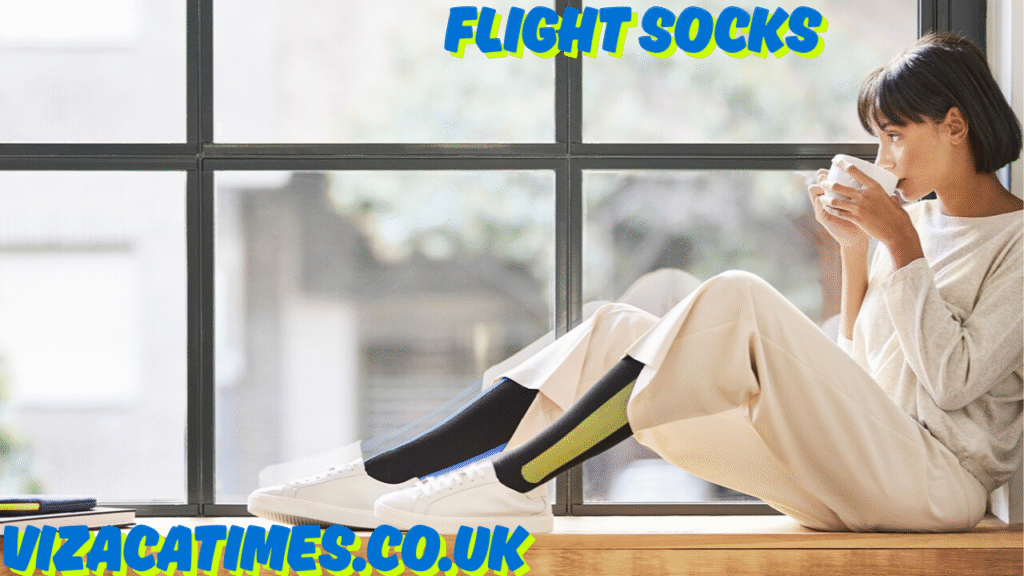Flight Socks, Benefits, Uses, and Travel Comfort?? Everything You Need to Know About Flight Socks

Flight Socks, Benefits, Travel Use, and Comfort??
When planning long-haul travel, most people focus on luggage, in-flight meals, or entertainment options. However, one small accessory can significantly improve your comfort and health during air travel: flight socks. Whether you are a frequent flyer or someone preparing for your first long-distance journey, understanding the purpose and function of flight socks is essential.
This article delves deep into the world of flight socks, exploring their medical benefits, how they work, the different types available, and why they’re increasingly recommended by health professionals and seasoned travelers alike.
What Are Flight Socks??

Flight socks, also known as compression socks or travel socks, are specially designed hosiery that applies gentle pressure to the lower legs. This pressure helps maintain blood flow and reduces discomfort and swelling caused by long periods of inactivity, particularly during long flights.
Unlike standard socks, flight socks have graduated compression—tighter at the ankle and gradually looser as they go up the leg. This design encourages blood to flow upwards towards the heart, combating circulation problems associated with sitting still for hours at a time.
Why Are Flight Socks Important During Air Travel??

One of the most concerning risks during long flights is Deep Vein Thrombosis (DVT), a condition where blood clots form in the deep veins, usually in the legs. DVT can become dangerous if the clot travels to the lungs, causing a pulmonary embolism. Air travel, especially flights longer than four hours, increases the risk due to extended immobility.
Flight socks are one of the simplest and most effective ways to reduce that risk. They:
- Improve circulation
- Decrease leg swelling
- Reduce muscle fatigue
- Lower the risk of DVT
For travelers with pre-existing health conditions, pregnant women, and older adults, the use of flight socks is even more crucial.
Who Should Use Flight Socks??
While flight socks are beneficial for almost anyone taking a flight longer than three to four hours, they are especially recommended for the following groups:
- Frequent Flyers and Long-Haul Travelers
Sitting for prolonged periods restricts circulation; flight socks combat this issue effectively. - Pregnant Women
Pregnancy increases the risk of blood clots and leg swelling. Flight socks offer crucial support and relief. - Elderly Passengers
As we age, the risk of circulation problems increases. Compression socks provide extra protection during air travel. - People With Medical Conditions
Those with varicose veins, prior history of thrombosis, or circulation disorders should use flight socks regularly. - Fitness Enthusiasts and Athletes
Active individuals often wear compression gear during recovery. Using flight socks during air travel supports muscle recovery and reduces stiffness.
How to Choose the Right Flight Socks??
Not all flight socks are created equal. Choosing the right pair depends on several factors such as compression level, material, size, and personal comfort. Here’s what you should consider:
- Compression Level (Measured in mmHg)
Most flight socks offer a mild to moderate level of compression, typically between 15-20 mmHg or 20-30 mmHg. Higher levels are available but often require medical consultation. - Fit and Sizing
Proper sizing is crucial. Ill-fitting socks can cause discomfort and defeat the purpose. Always refer to the manufacturer’s size chart. - Material
Look for breathable, moisture-wicking fabrics like nylon or a cotton-spandex blend to ensure comfort during long hours. - Length
Knee-high flight socks are the most common and effective, although thigh-high and full-length tights are available for more specialized needs.
How to Wear Flight Socks Properly??
Wearing flight socks the right way is essential to gaining their full benefits. Here’s how to do it:
- Put them on before you board
Ideally, wear them an hour before takeoff while you’re still mobile and swelling hasn’t started. - Ensure smooth, wrinkle-free fit
Wrinkles or bunching can cut off circulation instead of promoting it. - Wear them throughout the flight
Keep the socks on for the duration of the flight and a bit afterward if swelling occurs. - Don’t fold or roll them down
Rolling creates a tight band that may restrict circulation, doing more harm than good.
Common Myths About Flight Socks??
Despite their benefits, flight socks are sometimes misunderstood. Let’s clear up a few common misconceptions:
- “Only elderly or sick people need them.”
Wrong. Even young, healthy individuals are susceptible to circulation issues during long-haul flights. - “They’re uncomfortable or too tight.”
When properly fitted, flight socks feel snug but should not cause discomfort. A good pair feels supportive, not restrictive. - “Wearing loose clothes is enough to avoid DVT.”
While comfortable clothing helps, flight socks provide active support to circulation that loose clothing cannot.
Additional Travel Tips for Better Circulation
While flight socks are effective, they work best when combined with other circulation-friendly travel habits:
- Walk around the cabin every hour
Stretch your legs and flex your feet regularly. - Stay hydrated
Avoid alcohol and caffeine which can dehydrate you. Water improves blood flow and reduces swelling. - Avoid crossing your legs
This can constrict veins and reduce circulation in the lower limbs. - Elevate your feet when possible
A footrest or bag under your feet can help keep blood from pooling in your lower legs.
Medical Approval and Advice
For most people, flight socks are perfectly safe and beneficial. However, those with serious cardiovascular or arterial conditions should consult a doctor before using them. In rare cases, compression may be contraindicated.
Are Flight Socks Useful Beyond Flights??
Absolutely. Many people wear compression socks for:
- Long road trips or train rides
- Office jobs with prolonged sitting
- Recovery after running or workouts
- Maternity and postpartum support
- Standing professions like nursing or teaching
In short, the benefits of flight socks extend far beyond the airplane cabin. They’re a smart, supportive option for anyone who needs improved lower limb circulation or comfort during inactivity.
Final Thoughts on Flight Socks??
Flight socks may seem like a small part of your travel gear, but their impact is huge. Whether you’re jetting off for business, vacation, or visiting family overseas, adding a pair of flight socks to your packing list can significantly boost your comfort and health.
They aren’t just for those with existing health conditions—they’re for anyone who values wellness, convenience, and safe travel. If you’ve never used them before, now is the perfect time to try and feel the difference on your next trip.
FAQs About Flight Socks??
Q1: Can I wear flight socks daily?
Yes, especially if you spend long hours sitting or standing. Many professionals wear compression socks daily for support and fatigue reduction.
Q2: Do flight socks prevent swelling completely?
They significantly reduce swelling but may not eliminate it entirely, especially on very long flights or for people with certain health conditions.
Q3: Are flight socks washable and reusable?
Yes, most are machine washable and designed for long-term use. Always follow care instructions for longevity.
Q4: Can kids wear flight socks?
Children generally don’t need flight socks unless prescribed by a doctor. Always consult a pediatrician first.
Q5: How do I know if my flight socks are too tight?
If you experience pain, numbness, or skin marks, your socks may be too tight or the wrong size. Choose a snug but comfortable fit.
Conclusion
From comfort and health benefits to medical necessity, flight socks have become a travel essential for good reason. They offer simple yet powerful protection against the unseen risks of prolonged sitting. So next time you board a plane, make sure you pack a pair—you might just find them to be the most valuable item in your carry-on.
Also read : Kings Mill Hospital, ?? – Comprehensive Guide to Services, History, and Patient Experience



